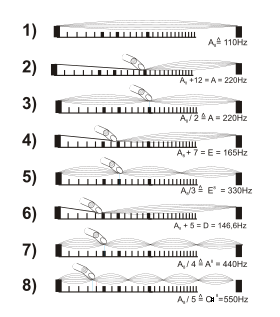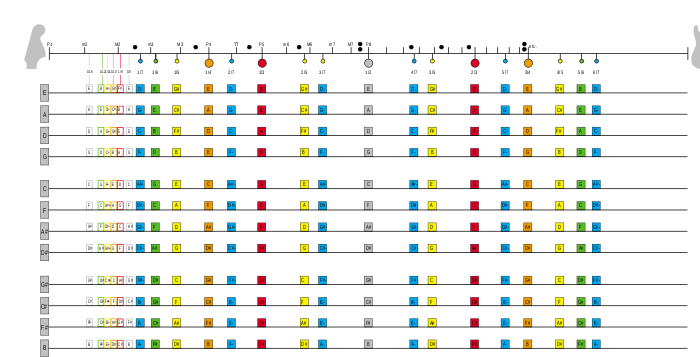String harmonic
Playing a string harmonic is a string instrument technique that uses the nodes of natural harmonics of a musical string to produce high pitched tones of varying timbre and loudness. Playing string harmonics produces "high pitched tones, like a whistle's, are produced when the musician lightly touches certain points on a string."[1] "A flute-like sound produced on a string instrument by lightly touching the string with the finger instead of pressing it down,"[2] against the fingerboard (without stopping).

Overtones
When a string is plucked normally, the ear hears the fundamental frequency most prominently, but the overall sound is also colored by the presence of various overtones (frequencies greater than the fundamental frequency). The fundamental frequency and its overtones are perceived by the listener as a single note; however, different combinations of overtones give rise to noticeably different overall tones (see timbre).[3] A harmonic overtone has evenly spaced nodes along the string, where the string does not move from its resting position.
Nodes

The nodes of natural harmonics are located at the following points along the string:
| Mode | Length fraction | Fret | Note |
|---|---|---|---|
| 1 | 1 | open | unison |
| 2 | 1⁄2 | 12 | octave |
| 3 | 1⁄3, 2⁄3 | 7, 19 | perfect twelfth = octave + perfect fifth |
| 4 | 1⁄4, 3⁄4 | 5, 24 | 2nd octave |
| 5 | 1⁄5 to 4⁄5 | 3.9, 8.8, 15.9, 27.9 | 2nd octave + just major third |
| 6 | 1⁄6, 5⁄6 | 3.2, 31.0 | 2nd octave + perfect fifth |
| 7 | 1⁄7 to 6⁄7 | 2.7, 5.8, 9.7, 14.7, 21.7, 33.7 | 2nd octave + septimal minor seventh |
| 8 | 1⁄8, 3⁄8, 5⁄8, 7⁄8 | 2.3, 8.1, 17.0, 36.0 | 3rd octave |
| 9 | 1⁄9, 2⁄9, 4⁄9, 5⁄9, 7⁄9, 8⁄9 | 2.0, 4.4, 10.2, 14.0, 26.0, 38.0 | 3rd octave + neutral second |
| 10 | 1⁄10, 3⁄10, 7⁄10, 9⁄10 | 1.8, 6.2, 20.8, 39.9 | 3rd octave + just major third |
Above, the length fraction is the point, with respect to the length of the whole string, the string is lightly touched. It is expressed as a fraction n/m, where m is the mode (1 through 10 are given above), and n the node number. The node number for a given mode can be any integer from 1 to m − 1. However, certain nodes of higher harmonics are coincident with nodes of lower harmonics, and the lower sounds overpower the higher ones. For example, mode number 4 can be fingered at nodes 1 and 3; it will occur at node 2 but will not be heard over the stronger first harmonic. Ineffective nodes to finger are not listed above.
The fret number, which shows the position of the node in terms of half tones (or frets on a fretted instrument) then is given by:
With s equal to the Twelfth root of two, notated s because it's the first letter of the word "semitone".
When a string is held down on the neck, the resulting harmonics are called artificial harmonics. In this case, as the total length of the string is shortened, the fundamental frequency is raised, and the positions of the nodes shift accordingly (that is, by the same number of frets), thereby raising the frequency of the overtone by the same interval as the fundamental frequency.
For sound examples as well as frequency differences in cents see Harmonics on stringed instruments.
Guitar
A guitar harmonic is a musical note played by preventing or amplifying vibration of certain overtones of a guitar string.
Harmonics are primarily generated manually, using a variety of techniques such as the pinch harmonic. Another method utilizes sound wave feedback from a guitar amplifier at high volume, which allows for indefinite vibration of certain string harmonics. Magnetic string drivers, such as the EBow, also use string harmonics to create sounds that are generally not playable via traditional picking or fretting techniques.
Harmonics are most often played by lightly placing a finger on a string at a nodal point of one of the overtones at the moment when the string is driven. The finger immediately damps all overtones that do not have a node near the location touched. The lowest-pitch overtone dominates the resulting sound.
Music using harmonics can contain very high pitch notes difficult or impossible to reach by fretting. Guitar harmonics also produce a different sound quality than fretted notes, and are one of many techniques used to create musical variety.
Pinch harmonics
A pinch harmonic (also known as squelch picking, pick harmonic or squealy) is a guitar technique to achieve artificial harmonics in which the player's thumb or index finger on the picking hand slightly catches the string after it is picked,[4] canceling (silencing) the fundamental frequency of the string, and letting one of the harmonics dominate. This results in a high-pitched sound which is particularly discernible on an electrically amplified guitar as a "squeal".
This action is sufficient to silence all harmonics except those that have a node at that location. This is sometimes accomplished by holding the plectrum so very little of its tip protrudes between the thumb and forefinger by roughly 3–5 mm (1⁄8–1⁄4 in), allowing the thumb to brush the string immediately after it is picked.
The technique must be performed at one of the appropriate harmonic nodes for the note to sound. For example, to produce a pinch harmonic one octave higher than the fundamental of a string that is stopped at the third fret of a guitar, the string must be plucked halfway between the third fret and the bridge (the 15th fret, as the neck is logarithmic). Other overtones of the same fundamental note may be produced in the same way at other nodes along the string. The point where the string is plucked therefore varies depending on the desired note. Most harmonics have several accessible nodes evenly spaced on the string, so the nodes used in practice are normally around where the string is normally picked (around the pickups on an electric guitar), rather than those above the neck as these are the easiest to access with the picking hand from normal playing. Overtones with a frequency of a multiple of the intended overtone will share the nodes of the lower overtones, so won't be muted.
A single harmonic overtone is quieter than a normal note, which contains many overtones. For this reason, guitar players often increase the guitar volume to play harmonics. Thicker strings, stronger pickups and adjustment to amplifier settings (increasing gain) are some ways of doing this. When the string vibrates primarily at a single fundamental, it has different volumes through different pickups, depending on the proximity of nodes or antinodes to the pickup. The different overtone volumes are why neck and bridge pickups sound different. If a node is directly over a pickup, little or no sound is heard.
Tapped harmonics
This technique was popularized by Eddie van Halen. Tapped harmonics are an extension of the tapping technique. The note is fretted as usual, but instead of striking the string the excitation energy required to sound the note is achieved by tapping at a harmonic nodal point. The tapping finger bounces lightly on and off the fret. The open string technique can be extended to artificial harmonics. For instance, for an octave harmonic (12-fret nodal point) press at the third fret, and tap the fifteenth fret, as 12 + 3 = 15.
Tap harmonic is a technique used with fretted string instruments (usually guitar). It is executed by tapping on the actual fret wire, most commonly at the 12th fret, but also can be executed by tapping any of the fret wires with proper technique. It can also be done by gently touching the string over the fret wire instead of tapping the fret wire if the string is already ringing. See also: Shred Guitar.
String harmonics driven by a magnetic field
This technique is used by effect devices producing a magnetic field that can agitate fundamentals and harmonics of steel strings. There are harmonic mode switches as provided by newer versions of the EBow and by guitar build in sustainers like the Fernandes Sustainer and the Moog Guitar. Harmonics control by harmonic mode switching and by the playing technique is applied by the Guitar Resonator where harmonics can be alternated by changing the string driver position at the fretboard while playing.
Use in rock and metal
The technique is possible on any fretted stringed instrument, but is most widely employed by electric guitarists, especially in heavy metal and rock music where heavy distortion ensures that the otherwise subtle harmonic is greatly amplified. An early example can be heard in Roy Buchanan's 1962 recording of "Potato Peeler".[5] Robbie Robertson, who learned the technique from Buchanan, used the technique, as did Leslie West.
A guitarist of the rock genre widely known for his use of pinch harmonics is Billy Gibbons of ZZ Top, who uses them frequently in guitar solos, an example being the second solo on the well-known "La Grange".
Another exponent of this technique was Irish blues rock guitarist Rory Gallagher, as in the track "Walk On Hot Coals" from the album Irish Tour '74.
Artists such as Eddie Van Halen, Joe Satriani and Steve Vai made the technique popular, utilizing the tremolo arm and high gain amps together with the pinch harmonic to produce horse-like wails from the instrument.
Billy Corgan often uses the technique in Smashing Pumpkins songs, notably in "Mayonaise", where he uses pinch harmonics in the intro without distortion.
The technique is used commonly in heavy metal, particularly by guitarists such as Criss Oliva, Adam Dutkiewicz, Tommy Victor, Steve Morse, Mick Thomson, Glenn Tipton, John Sykes, Zakk Wylde, Angus Young, Randy Rhoads, Mark Morton, Synyster Gates and Dimebag Darrell. Pinch harmonics are used extensively in death metal, often included in riffs rather than reserved for solos. Combined with the rather low tunings common to the genre, and the fact that they are usually played by both rhythm guitarists (if there are two), the pinched notes leap out, creating more complex and twisted melodic contours than otherwise possible.
See also
References
- Kamien, Roger (2008). Music: An Appreciation, p.13. Sixth "brief" edition. McGraw Hill. ISBN 978-0-07-340134-8.
- Palisca, Claude V.; ed. (1996). Norton Anthology of Western Music, Volume 1: Ancient to Baroque, glossary, p.601. Third edition. W. W. Norton. ISBN 0-393-96906-1.
- "The Physics of Everyday Stuff - The Guitar". www.bsharp.org. Retrieved 2015-08-03.
- "Guitar Techniques: Pick Harmonic", XtremeMusician.com. Accessed: December 19, 2017.
- "" 10 Things You Gotta Do To Play Like Roy Buchanan", GuitarPlayer.com". Archived from the original on 12 February 2009. Retrieved 2018-04-10.CS1 maint: BOT: original-url status unknown (link)
External links
Pinch harmonic
- Guitar Harmonics Lesson - A lesson covering the various types of harmonics that can be played on a guitar and how to play them.
- Pinch Harmonics at Cyberfret
- Animated Pinch Harmonic Examples at ActionTab